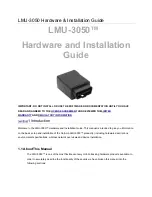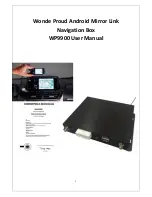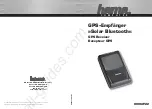
GPS and GLONASS Concepts
A-3
GPS and GLONASS
Signal Structure
GPS and GLONASS have similar signal structures.
•
Both transmit on two frequency bands, LI and L2
•
Both have PRN codes in the LI frequency band, known as Coarse/
Acquisition (C/A) code for GPS, and standard (S) code for GLONASS
•
Both transmit almanac and ephemerides at a data rate of 50 bus. The GG
Surveyor tracks the LI C/A and S codes from both GPS and GLONASS
•
Both have PRN codes that repeat every one millisecond (C/A for PS and S
for GLONASS)
Differences in Signal Structure
The difference between GPS and GLONASS signal structures is that GPS uses the
same frequencies but different PRN codes for each satellite (CDMA, Code Division
Multiple Access). GLONASS uses the same PRN codes for each satellite, but
different frequencies within the LI and L2 bands (FDMA, Frequency Division
Multiple Access). A PRN code identifies each GPS satellite. GPS PRN codes are
numbered from 1 through 32, 24 of which are used for the full constellation.
GLONASS satellites are identified by their orbital slot number. There are 24 orbital
slots, numbered sequentially 1 through 24. The satellite takes the slot number it
occupies.
Differences in Implementation
The major difference in implementation between GPS and GLONASS is that GPS
has SA on both C/A and P codes. The codes are deliberately degraded by dithering
the transmit time. GLONASS has no deliberate degradation. GPS encrypts the P code
on both L1 and L2; the encrypted code is secret, this is known as AS (Anti-Spoofing).
GLONASS has no encryption.
GPS and GLONASS satellites transmit orbit information about the satellites in
almanacs. Each satellite transmits an almanac which tells the receiver which satellites
are operating and where they are. This is how the receiver knows which satellites are
above the horizon. GPS satellites are identified in their almanac by their PRN
numbers, while GLONASS satellites are identified by their orbital slot (ID) numbers.
Each slot number has an associated carrier number in the almanac which tells the GG
Surveyor receiver which frequency the satellite is on.
Each GPS satellite transmits at an L1 frequency of 1575.42 MHz, and at an L2
frequency of 1227.60 MHz. Each GLONASS satellite transmits at an L1 frequency of
1602 + K(9/16 MHz), and at an L2 frequency of 1246 + K(7/16 MHz). K is the carrier
number given in the almanac for each satellite. Currently K is in the range 1 through
24. The GG Surveyor is an L1-only receiver.
Summary of Contents for GG Surveyor
Page 14: ...xiv GG Surveyor GPS GLONASS Reference Manual...
Page 38: ...20 GG Surveyor GPS GLONASS Reference Manual...
Page 62: ...44 GG Surveyor GPS GLONASS Reference Manual...
Page 86: ...68 GG Surveyor GPS GLONASS Reference Manual...
Page 232: ...B 6 GG Surveyor GPS GLONASS Reference Manual...
Page 236: ...C 4 GG Surveyor GPS GLONASS Reference Manual...
Page 246: ...E 6 GG Surveyor GPS GLONASS Reference Manual...
















































